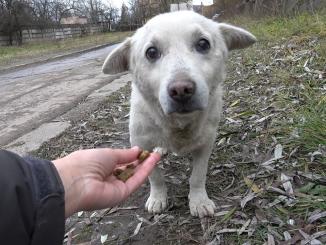
It may be hard to watch this viral video that shows the harsh reality of animal neglect. Harold was skin and bone when he was found wandering the streets in North Oshawa in Ontario, Canada. But now is thriving and just like any other puppy—thanks to his foster carer.
Kayleigh McGovern, a volunteer and team member at Oshawa Animal Services, decided to look after the emaciated dog who was too weak to even walk back in July. She documented his progress and shared a slideshow of images on her TikTok page.
Kathy Pittman-Feltham, the shelter manager told Newsweek: “Harold quickly captured all of our hearts and we were rooting for him to get healthy and find his forever home.”

In the viral video that has 791,800 views, @kayleigh_mcgovern added on-screen text to explain each image. She stated he spent the first three days in bed and he didn’t have the strength to empty his bladder.
She wrote: “We shared many cuddles, watched lots of shows, and most importantly he got lots of rest.”
One image shows Harold’s skeletal body as the on-screen text explains: “This picture is still so jarring to look at. He was examined at the vet for possible causes of his emaciation. The vets concluded the only thing wrong with him was that he was essentially starving to death.”
After a few days of tender love and care, Harold started to feel stronger and became playful. Now four months on, he is just like any other puppy.
Pittman-Feltham told Newsweek: “Kayleigh helped nurse him back to health and he was then adopted by a member of the community who is a second-time adopter from us.
“He is doing phenomenal and is the perfect picture of health.”
Harold’s remarkable transformation has touched the hearts of thousands of TikTok users. But sadly, his situation wasn’t a rare case.

Each year 6.3 million pets are surrendered to U.S. shelters, which is an average of 17,260 a day, according to the American Society for the Prevention of Cruelty to Animals.
Around 920,000 surrendered animals are euthanized every year. Shelters are striving to minimize euthanasia rates by promoting adoption campaigns, spaying and neutering programs, and behavior rehabilitation.
Pittman-Feltham told Newsweek: “We see many sad cases come through our doors and the team is always excited to be a part of the next chapter in their story as most times we don’t have any information on their past.
“We are hoping Harold’s story shines a light on the many cases across the rescue world that need our help.

“Fostering saves lives and Harold is a perfect example of that!“
Dogs actually do respond better when their owners use cute ‘baby talk’, study finds
Dogs’ brains are sensitive to the familiar high-pitched “cute” voice tone that adult humans, especially women, use to talk to babies, according to a new study.
The research, published recently in the journal Communications Biology, found “exciting similarities” between infant and dog brains during the processing of speech with such a high-pitched tone feature.
Humans tend to speak with a specific speech style characterised by exaggerated prosody, or patterns of stress and intonation in a language, when communicating with individuals having limited language competence.
Such speech has previously been found to be very important for the healthy cognitive, social and language development of children, who are also tuned to such a high-pitched voice.
But researchers, including those from the Eötvös Loránd University in Hungary, hoped to assess whether dog brains are also sensitive to this way of communication.
In the study, conscious family dogs were made to listen to dog, infant and adult-directed speech recorded from 12 women and men in real-life interactions.
As the dogs listened, their brain activities were measured using a functional magnetic resonance imaging (fMRI) scan.
The study found the sound-processing regions of the dogs’ brains responded more to dog- and infant-directed than adult-directed speech.
This marked the first neurological evidence that dog brains are tuned to speech directed specifically at them.
“Studying how dog brains process dog-directed speech is exciting, because it can help us understand how exaggerated prosody contributes to efficient speech processing in a nonhuman species skilled at relying on different speech cues,” explained Anna Gergely, co-first author of the study.
Scientists also found dog- and infant-directed speech sensitivity of dog brains was more pronounced when the speakers were women, and was affected by voice pitch and its variation.
These findings suggest the way we speak to dogs matters, and that their brain is specifically sensitive to the higher-pitched voice tone typical to the female voice.
“Remarkably, the voice tone patterns characterizing women’s dog-directed speech are not typically used in dog-dog communication – our results may thus serve evidence for a neural preference that dogs developed during their domestication,” said Anna Gábor, co-first author of the study.
“Dog brains’ increased sensitivity to dog-directed speech spoken by women specifically may be due to the fact that women more often speak to dogs with exaggerated prosody than men,” Dr Gabor said.




Leave a Reply